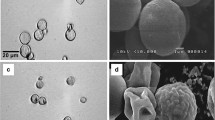Abstract
The structural damage to and leakage of internal substances from Saccharomyces cerevisiae 0–39 cells induced by hydrostatic pressure were investigated. By scanning electron microscopy, yeast cells treated at room temperature with pressuresbellw 400 MPa for 10 min showed a slight alteration in outer shape. Transmission electron microscopy, however, showed that the inner structure of the cell began to be affected, especially the nuclear membrane, when treated with hydrostatic pressure around 100 MPa at room temperature for 10 min; at more than 400–600 MPa, further alterations appeared in the mitochondria and cytoplasm. Furthermore, when high pressure treatment was carried out at — 20° C, the inner structure of the cells was severely damaged even at 200 MPa, and almost all of the nuclear membrane disappeared, although the fluorescent nucleus in the cytoplasm was visible by 4,6-diamidino-2-phenylindole (DAPI) staining. The structural damage of pressure-treated cells was accompanied by the leakage of internal substances. The efflux of UV-absorbing substances including amino acid pools, peptides, and metal ions increased with increase in pressure up to 600 MPa. In particular, amounts of individual metal ion release varied with the magnitude of hydrostatic pressures over 300 MPa, which suggests that the ions can be removed from the yeast cells separately by hydrostatic pressure treatment.
Similar content being viewed by others
References
Bernt E, Bergmeyer HU (1974) Glutathione. In: Bergmeyer HU (ed) Methods of enzymatic analysis, vol 4. Academic Press, New York, pp 1643–1647
Butz P, Ludwig H (1991) Hochdruckinaktivierung von Hefen und Schimmelpilzen. Pharm Ind 53:584–586
Hamada K, Nakatomi Y, Shimada S (1992) Direct induction of tetraploids or homozygous diploids in the industrial yeast, Saccharomyces cerevisiae by hydrostatic pressure. Curr Genet 22:371–376
Kriss AE, Mishustina JE, Zheleznikova VA (1969) Change in ultrastructure and chemical composition of bacterial cells under the influence of high hydrostatic pressure. Mikrobiologiya (English translation) 38:108–113
Marquis RE (1976) High-pressure microbial physiology. Adv Microbiol Physiol 14:158–241
Matsumura P, Keller DM, Marquis RE (1974) Restricted pH ranges and reduced yields for bacterial growth under pressure. Microb Ecol 1:176–189
Osumi M, Torigata S (1976) Surface structure of microbodies isolated from yeast cells. Scanning Electron Microsc II:617–622
Osumi M, Fukuzumi F, Teranishi Y, Tanaka A, Fukui S (1975) Development of mibrobodies in Candida tropicalis during incubation in a n-alkane medium. Arch Microbiol 103:1–11
Rosin MP Zimmerman AM (1977) The induction ofcytoplasmic petite mutants of Saccharomyces cerevisiae by hydrostatic pressure. J Cell Sci 26:373–385
Sando N, Miyakawa I, Nishibayashi S, Kuroiwa T (1981) Arrangement of mitochondrial nucleoids during life cycle of Saccharomyces cerevisiae. J Gen Appl Microbiol 27:511–516
Schmid G, Ludemann HD, Jaenicke R (1975) High pressure effects on the activity of glycolytic enzymes. Biophys Chem 3:90–98
Suzuki K, Miyosawa Y, Taniguchi Y (1971) The effect of pressure on deoxyribonucleic acid. J Biochem 69:595–598
Suzuki K, Miyasawa Y, Taniguchi Y (1972) The effect of pressure on the adsorption spectra of deoxyribonucleic acid and deoxyribonucleic acid-dye complex. J Biochem 72:1087–1091
Thibault J, Leduyy A, Cote F (1987) Production of ethanol by Saccharomyces cerevisiae under high-pressure conditions. Biotechnol Bioeng 30:74–80
Zimmerman AH (1971) High pressure studies in cell biology. Int Rev Cytol 30:1–47
ZoBell CE (1970) Pressure effects on morphology and life processes of bacteria. In: Zimmerman AH (ed) High pressure-effects on cellular processes. Academic Press, New York, pp 85–130
Author information
Authors and Affiliations
Additional information
Correspondence to: S. Shimada
Rights and permissions
About this article
Cite this article
Shimada, S., Andou, M., Naito, N. et al. Effects of hydrostatic pressure on the ultrastructure and leakage of internal substances in the yeast Saccharomyces cerevisiae . Appl Microbiol Biotechnol 40, 123–131 (1993). https://doi.org/10.1007/BF00170440
Received:
Accepted:
Issue Date:
DOI: https://doi.org/10.1007/BF00170440




